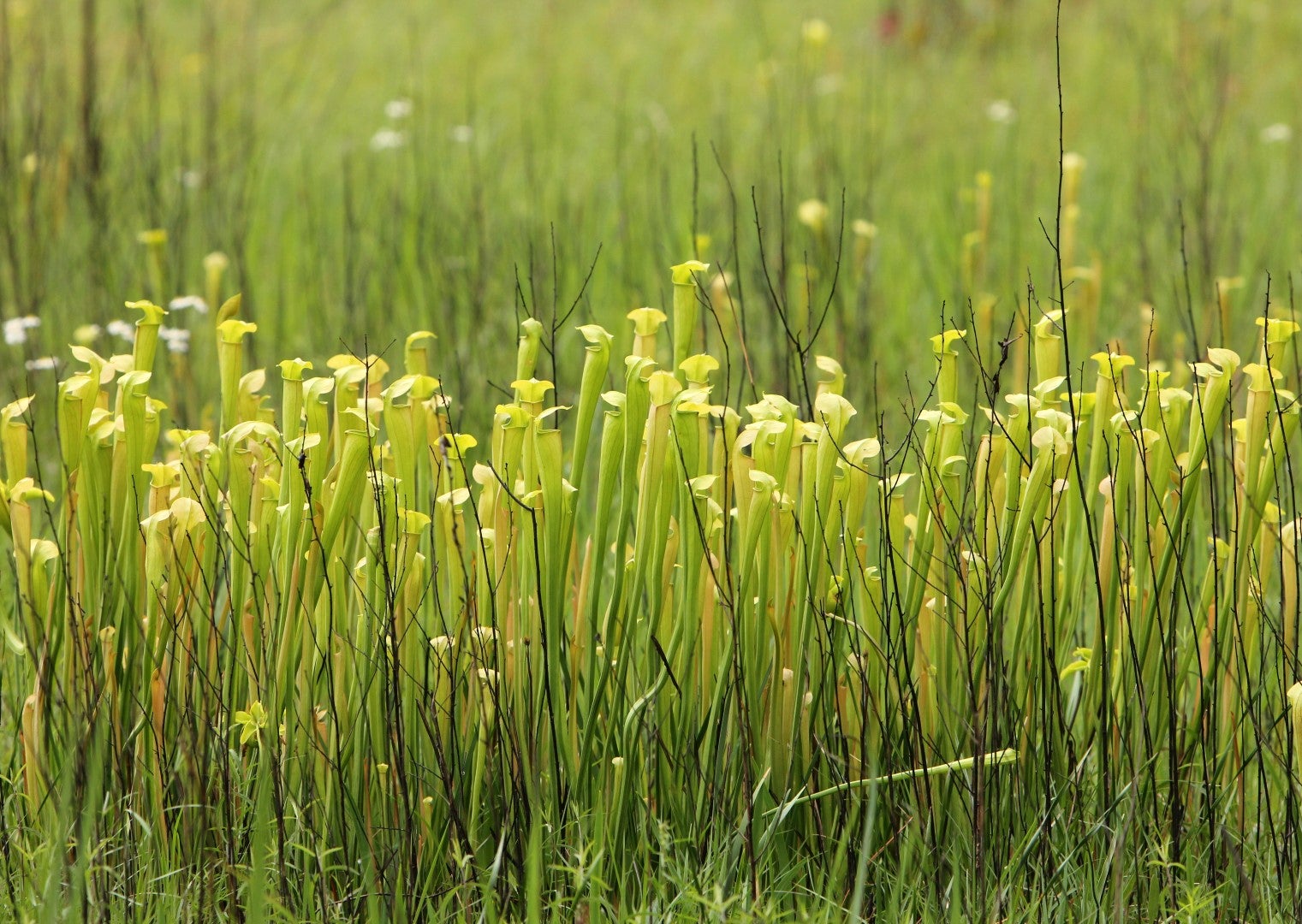The Crosby Arboretum’s plant bog is a tapestry of summer wildflowers
Published 4:54 pm Friday, June 4, 2021

- The yellow pitcher plants (Sarracenia alata) are now fully developed and their hollow modified leaves are busy trapping and digesting insects, supplementing their diet with an additional source of nitrogen from the insects’ bodies.
By Pat Drackett
Director of the Crosby Arboretum and
assistant extension professor of landscape architecture with the Mississippi State University Extension Service.
On our field walk to the Arboretum’s South Pitcher Plant Bog last Saturday we were treated to a crazy quilt of summer perennials. In summer, Mississippi’s wildflowers put on glorious show of color. And truthfully, this roller coaster ride of blooms in the Arboretum’s 20-acre Savanna Exhibit doesn’t end until the fall.
We discussed some of the native perennials growing in the South Bog which can be grown in a typical garden, such as blazing star (Liatris spicata), blue-eyed grass (Sisyrinchium angustifolium), and swamp sunflower (Helianthus angustifolius). The majority of the species that grow here, although many are highly attractive perennials, are best when left to prosper in their natural environmental conditions, such as the pitcher plants (Sarracenia), sundew (Drosera), milkworts (Polygala) and meadow beauties (Rhexia).
As we entered the south bog, a multi-colored blanket of blooms lay before us. Silvery-gray clusters of goldencrest (Lophiola aurea) are scattered throughout the grasslands and create a delightful rhythm to the landscape. The bog is currently dominated by yellow and pink meadowbeauties (Rhexia spp.)
Goldencrest and its companion species are found in these moist pine savannas, growing with carnivorous species such as the yellow and parrot pitcher plants. We saw several white bloom clusters that resembled garlic. This is redroot (Lachnanthes caroliana), which earns its name from the roots being used by Native Americans as a dye. Without their single bloom stalks, redroot resembles a small iris in early spring.
Flowers in the grasslands range from the tall to the tiny. At least five species of petite candy root (Polygala) can be found in the Savanna Exhibit, in shades of pink, white, purple, yellow and orange. Typically ranging from around two to six inches tall, these plants are known as milkworts. Their unusually shaped blooms are attractive to butterflies such as skippers which are drawn to their nectar. These plants are nicknamed “candy root” because their roots will often have an aroma like wintergreen candy.
A thin-stemmed flower common to the bog is the lady’s hatpin (Eriocaulon). Called pipewort or bog buttons, it grows in great profusion. Later in the year it will give the savanna landscape the appearance of a swaying sea of polka dots. The current treat is the abundant quantity of orange-red blooms of the fewflower milkweed (Asclepias lanceolata), held high on stems towering 3 to 4 feet in height.
From our boardwalk, you’ll see this bright orange milkweed, and clusters of tiny red-hued parrot pitcher plants. The small openings in their hollow modified leaves only pose a threat to tiny insects like ants. Tall pods of purple longleaf milkweed (Asclepias longifolia) nearby indicate that bloom time is over, and they are preparing to release seed.
Some plants, like the milkweed, would be happy in your home bog garden, with some planning. Visit our bog display on the Arboretum deck, a wooden raised planter box built by grounds manager Terry Johnson and carpenter volunteer Tom Heim. You can install a liner in such a box, use a rigid plastic pond container available at garden centers, or simply add sphagnum peat moss to a low area of your property with constantly saturated soil. See the MSU Extension website at http://extension.msstate.edu/ to access the information sheet, “Creating a Bog Garden”. Just enter this title in the home page search engine.
Mark your calendar for a Yoga class on Pinecote Pavilion Saturday, June 19 from 9:30 – 10:30 a.m. or attend the wire-wrapped jewelry workshop with Connie Boyd of Unique Stones that same Saturday from 9:30 a.m. to 12:30 p.m. Make and take a beautiful handmade pendant with a semi-precious stone wrapped in Sterling Silver wire. Cost is $70 and includes a chain, tools for use, silver wire, and your choice of stone, paid directly to the instructor the day of the workshop.
Attend a Plant Propagation Workshop with Dr. Eddie Smith, Pearl River County Extension Agent Friday, July 16, from 10:00 a.m. to Noon. The program begins with a presentation covering basic propagation techniques and will move into the Arboretum greenhouse for hands-on activities. You will take home plants!
“All About Hummingbirds” program with long-time hummingbird bander James Bell is Saturday, August 14 from 9:30 to 10:30 a.m. Reservations are required for programs. Call 601-799-2311 to sign up (and pay when you arrive). Details for these programs and more will be posted soon on our website calendar and Facebook page.
You may also sign up for our email listserv to receive periodic announcements of upcoming programs on our website under “Event Updates” at www.crosbyarboretum.msstate.edu<http://www.crosbyarboretum.msstate.edu>. The Crosby Arboretum is located in Picayune, I-59 Exit 4, at 370 Ridge Road (south of Walmart and adjacent to I-59).




